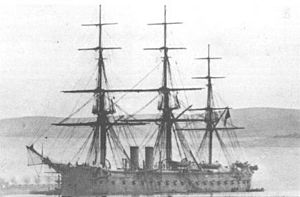Spanish ironclad Tetuán facts for kids
class="infobox " style="float: right; clear: right; width: 315px; border-spacing: 2px; text-align: left; font-size: 90%;"
| colspan="2" style="text-align: center; font-size: 90%; line-height: 1.5em;" | 
|} The Spanish ironclad Tetuán was a powerful warship. It was an armored frigate built in Spain in the 1860s. The ship was made for the Spanish Navy at the royal shipyard in Ferrol. In 1873, rebels took control of the ship during a time of unrest called the Cantonal Revolution. The Tetuán even fought in a sea battle near Cartagena. While being fixed after the battle, the ship caught fire and was destroyed. It was later taken apart in 1874.
Contents
| History | |
|---|---|
| Name | Tetuán |
| Namesake | Battle of Tétouan |
| Builder | Royal dockyard, Ferrol |
| Laid down | May 1861 |
| Launched | March 1863 |
| Completed | January 1866 |
| Commissioned | June 1866 |
| Fate |
|
| General characteristics (as built) | |
| Type | Armored frigate |
| Displacement | 6,200 long tons (6,300 t) |
| Length | 279 ft 1 in (85.1 m) |
| Beam | 55 ft 9 in (17.0 m) |
| Draft | 21 ft 8 in (6.6 m) |
| Installed power | 4,520 ihp (3,370 kW) |
| Propulsion |
|
| Sail plan | Ship rig |
| Speed | about 10 knots (19 km/h; 12 mph) |
| Complement | 584 |
| Armament | 30 × 68-pounder smoothbore guns |
| Armor |
|
What was the Tetuán like?
The Tetuán was a large ship. It was 279 feet 1 inch (85.1 m) long at the waterline. The ship was 55 feet 9 inches (17.0 m) wide and had a draft of 21 feet 8 inches (6.6 m). It weighed about 6,200 long tons (6,300 t).
Engines and Speed
The Tetuán had one main steam engine. This engine used steam from eight boilers. It was designed to make 4,520 indicated horsepower (3,370 kW) of power. This allowed the ship to reach a speed of about 10 knots (19 km/h; 12 mph). For longer trips, the Tetuán also had three masts and could use sails. It could carry 1,200 long tons (1,219 t) of coal for its engines.
Weapons and Protection
The ship was armed with thirty 68-pounder smoothbore guns. These were powerful cannons for their time. To protect itself, the Tetuán had strong wrought-iron armor. This armor was 5.1 inches (130 mm) thick around its waterline. It also protected the battery, which is where the guns were located.
Building and Service of the Tetuán
The Tetuán was named after the 1860 Battle of Tétouan. It was built at the Royal dockyard in Ferrol, Spain. The ship's construction started in May 1861. It was launched into the water in March 1863. The Tetuán was finally finished in January 1866.
The Cantonal Revolution
In the middle of 1873, Spain was facing a lot of trouble. The First Spanish Republic was fighting the Third Carlist War. At the same time, a new conflict called the Cantonal Revolution began. Rebels took control of the city of Cartagena on July 12. Many Spanish Navy ships were in port there, including the Tetuán. Other ships included the armored frigates Vitoria and Numancia. There was also the armored corvette Méndez Núñez.
Battle and End of the Ship
Later, on October 11, the rebel ships Numancia, Tetuan, and Méndez Núñez were at sea. A smaller government fleet attacked them near Cartagena. This fleet was led by the Vitoria. The government ships did not want to sink the rebel ships. So, they kept their distance. The rebels tried to get closer but could not. In this fight, the rebel ships had 13 people killed and 49 wounded. The Tetuán was damaged during this battle.
The ship was being repaired when it was destroyed by fire. This happened on December 30 or 31, 1873. It is not clear if the fire was an accident or set on purpose. This happened just two weeks before the city of Cartagena surrendered to the government. After the fire, the Tetuán was broken up in 1874.
See also
 In Spanish: Tetuán (1863) para niños
In Spanish: Tetuán (1863) para niños

